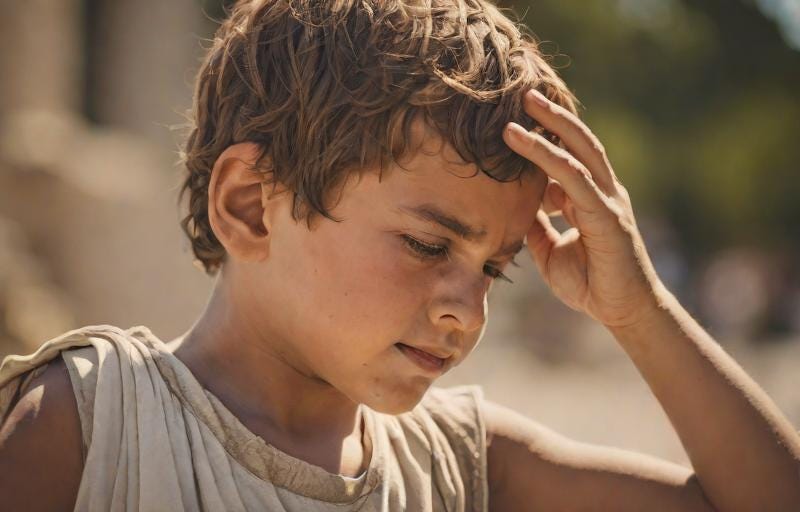Dear Classical Wisdom Kids,
We pause our regularly scheduled issue for this Classical KIDS Service Announcement.
For thousands of years philosophy has provided support, comfort and wisdom to a wide range of human concerns... from the largest most difficult worries to the smallest most annoying irritations...
Today we will address the latter... a problem as old as humans: Head Lice.
In fact, they have found head lice on ancient mummies! Ancient Egyptians used to shave their heads and wear wigs to avoid lice... but if they did get them, they would use a treatment of water, vinegar, oil of cinnamon, oil of rosemary, oil of terebinth. The ancient Chinese discovered that Pyrethrum powder obtained from dried flowers of at least one species of chrysanthemum exhibited insecticidal properties… it’s still one of the main ingredients used now!
Today about 6–12 million people, mainly children, are treated annually for head lice in the United States alone... while in the UK, it is estimated that two thirds of children will experience at least one case of head lice before leaving primary school. Unfortunately, head lice outbreaks are on the rise (as are super lice! ek!) So whether or not you are thinking about it now... you probably will at some point.
As a problem, the issue of head lice is universal... it’s timeless... and so of course the ancients can help, right?
While the actual medical advice offered by Hippocrates, as well as Aristotle’s student Theophrastus, still works - the use of olive oil or vinegar, followed with a fine tooth comb, it’s usually recommended that you go with the more efficient over the counter options that you can find today.
Instead, we’ll turn to the ancients -specifically the Stoics- for important and fun ways to both think about head lice... and prevent it in the future.
And yes! I did say fun!
So stop scratching and start learning... with today’s activities provided by Elizabeth Smith, below.
Enjoy!
All the best,
Anya Leonard
Founder and Director
Classical Wisdom and Classical Wisdom Kids
P.S. While our games and activities are usually reserved for members only, we felt this was an important issue that should be open to all, so please enjoy this special edition/service announcement… and feel free to share it!
I would like, however, to take a moment to give a special thanks to our dear members whose subscriber dues make this work possible. If you are not already a member, but you appreciate the work we do here, kindly consider joining our growing community here today…
LICE Lessons
The Stoic Opposition (Against LICE)
To battle a lice infestation you may need to call upon, and practice, what Stoics refer to as the four virtues.
Wisdom: Learning as much as you can about lice and how to get rid of them. Knowing that you will not have lice forever.
Justice: Doing your best not to spread lice to your friends and family. Your dog and cat are safe.
Courage: You must be brave. Lice will NOT kill you… When Marcus Aurelius said lice killed Socrates he was speaking metaphorically.
Temperance: You may have to spend hours under a nit comb, and endure several treatments. Look at this as a great opportunity for practicing temperance.
Epictetus and the Dichotomy of Lice
When facing hard times, the Stoic philosopher Epictetus is considered a great source of inspiration. Epictetus taught the importance of knowing what is inside and outside of one’s control.
Epictetus advises us that we should not focus or worry about what is outside of our control. Instead we should focus on what is inside of our control.
"Happiness and freedom begin with a clear understanding of one principle: Some things are within our control, and some things are not." - Epictetus
This Stoic practice of the Dichotomy of Control might be what you need to battle a head full of lice, or possibly avoid them all together.
As Epictetus would have us ask ourselves, “What is inside and outside of our control?” Inside of our control are our intentions, judgments, and actions. Outside of our control is everything else.
Let’s put this into practice…
Your school has an infestation of lice! Is this inside or outside of your control? (Answer: Outside)
So, due to the fact that the lice infestation is outside of our control, we are not going to worry about it. Instead, we are going to focus on what is inside of our control: our responses and actions.
Inside of my control is to wear my hair pulled back.
Inside of my control is to use a preventative lice spray (see our ancient recipes).
Inside of my control is to put coconut oil in my hair so lice will have trouble attaching their eggs (why do you think this works? Think like Aristotle!)
Inside of my control is to not share hats.
Inside of my control is to avoid putting my head next to my friend’s head while we take a selfie or draw a picture.
Let’s say, despite all of your awesome effort, the lice have successfully moved into your lovely locks, and have started a family (FUN FACT: female lice - with a life cycle of 30 days - will lay 6 eggs a day!) THIS is now outside of your control.
No worries, you can still look for what is inside of your control.
Inside of my control is to tell a grownup my head itches.
Inside of my control is to remove the lice by using a special nit comb.
Inside of my control is to wash my hair, using a special shampoo.
Inside of my control is to wash my pillowcase and sheets in hot water.
Inside of my control is to vacuum carpets, wash toys, and bag up items in trash bags that can’t be washed (Bagged for 48 hours will suffocate the lice).
And if needed…
Inside of my control is to see a doctor.
A quick recap:
Your friend - who has an itchy head - asks to borrow your hairbrush; is lending your hairbrush inside or outside of your control? (Answer: Inside!)
Our actions and responses are inside of our control. Itchy head or not, the action you should take is to say NO to sharing. Kindly respond to your friend’s request by telling them that you do not share your hairbrush with others.
Can you think of more lice preventive strategies that are inside of your control? Let us know! Unlike lice, it’s always nice to share helpful ideas with other Classical Kids.
***NB: You will notice that this activity, as well as the one below, can be used for other problems… not just lice! If there is something your child/children are dealing with, feel free to apply the same thinking practices and perspectives to the issue.***
A View from Above
Is having a head full of lice horrible and embarrassing? It doesn’t have to be. Epictetus said, “It is not things that upset us, but our judgment about things.” What if having lice isn’t the worst thing in the world? What if we could shrink our anxieties and judgments about having lice? Shrink them down to the size of a nit (nits are lice eggs)...maybe even smaller. Would that make you feel better? Less embarrassed?
The Stoic philosophers would say YES.
When we focus too closely on a problem, the problem appears larger than it actually is, and the rest of our world becomes very small. In order to shrink our lice problem, and expand our world… it is helpful to look at the problem with a view from above.
Here is a special practice the great Roman emperor Marcus Aurelius liked to use when he needed to rise above his many problems. He, like Socrates, had several encounters with lice…metaphorically speaking.
In modern times this contemplative practice is referred to as the View from Above. Give it a try!
To begin, close your eyes and imagine yourself floating up to the ceiling. Notice while looking down at yourself, “Here I am, sitting there with my hair full of lice.”
Now go up further into the sky, see all of the buildings in your neighborhood. Notice the people and cars moving about their day; and there you are, sitting with your hair full of lice.
Next, you float up higher into the sky. You see your entire city. Notice all of the people in their homes and workplaces. Dogs and cats in their yards… See the buses and trains. And there you are, way down there looking even smaller, sitting there with your hair full of lice. The lice are getting smaller.
Continue floating up into the sky, and further away from your problem. Notice how small the lice in your hair appear as you take in all the details of your hometown, country, and then planet…Continue to check in, and notice how small you and your lice problem is in comparison to the rest of the universe.
You and your problem are so teeny tiny, smaller than a speck of sand, smaller than an atom...

Look out over the galaxy. Realize that you are not the first person to have lice. For thousands of years people have been battling lice. You are not the only person with lice. At this moment there are thousands of people on planet Earth battling lice.
And in the future, most likely people will be inconvenienced by lice.
You are not alone in your battle.
Speaking of battles…
Gaia Battles Lice
Time for a game!
In Greek mythology, Gaia is the personification of the Earth.
Grab a bunch of friends, and head outside to a nice area of Gaia (yard).
Choose one player to be the caller. All other players will be the lice. In this running game, the caller will call out one of the four commands. Players must quickly perform the commands as they are called.
DARK (as in night): Lice like the dark and are most active at night. All the lice must run around on Gaia as fast as they can.
LIGHT (as in flashlight): All lice (players) must run to the fence (or a designated space). Lice do not like the light. The last player to reach the fence (area) is out. AKA one of the lice is removed from Gaia.
SPRAY (as in lice spray): Lice find the spray repulsive. When this command is given, all lice (players) must freeze. Any moving lice are out/removed.
COMB: (as in a special nit comb): Upon hearing this command all lice must drop flat to Gaia (the ground). Nit combs find lice and nits usually close to the skin, and remove them (To get rid of lice you must physically remove them. They will not go away on their own). Last lice to hit the ground is out/removed.
As in real life, the game is played until Gaia is lice free.






This reminds me of a thought I had regarding Works and Days. The works should be updated to teach kids stuff of today; leave out the geneology. Then, all kids should have to read it annually up to an age…..